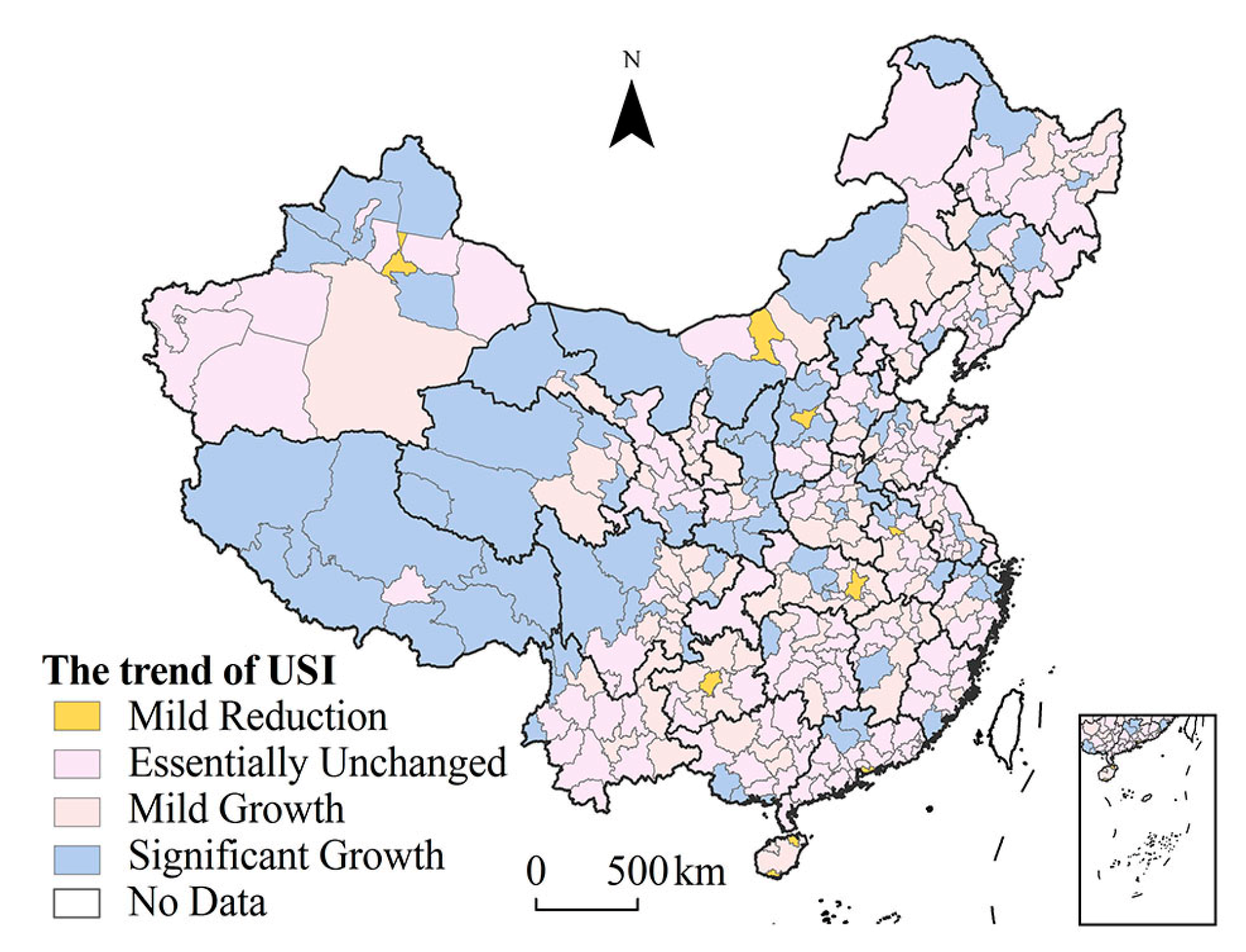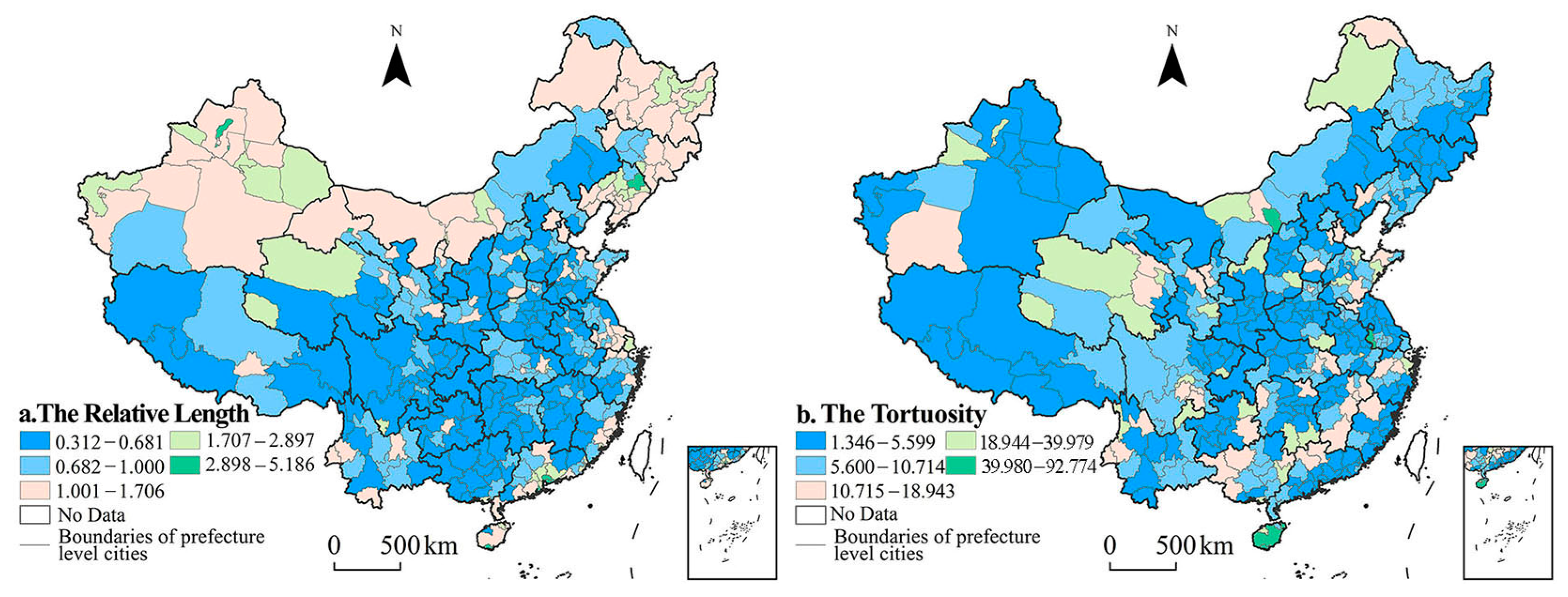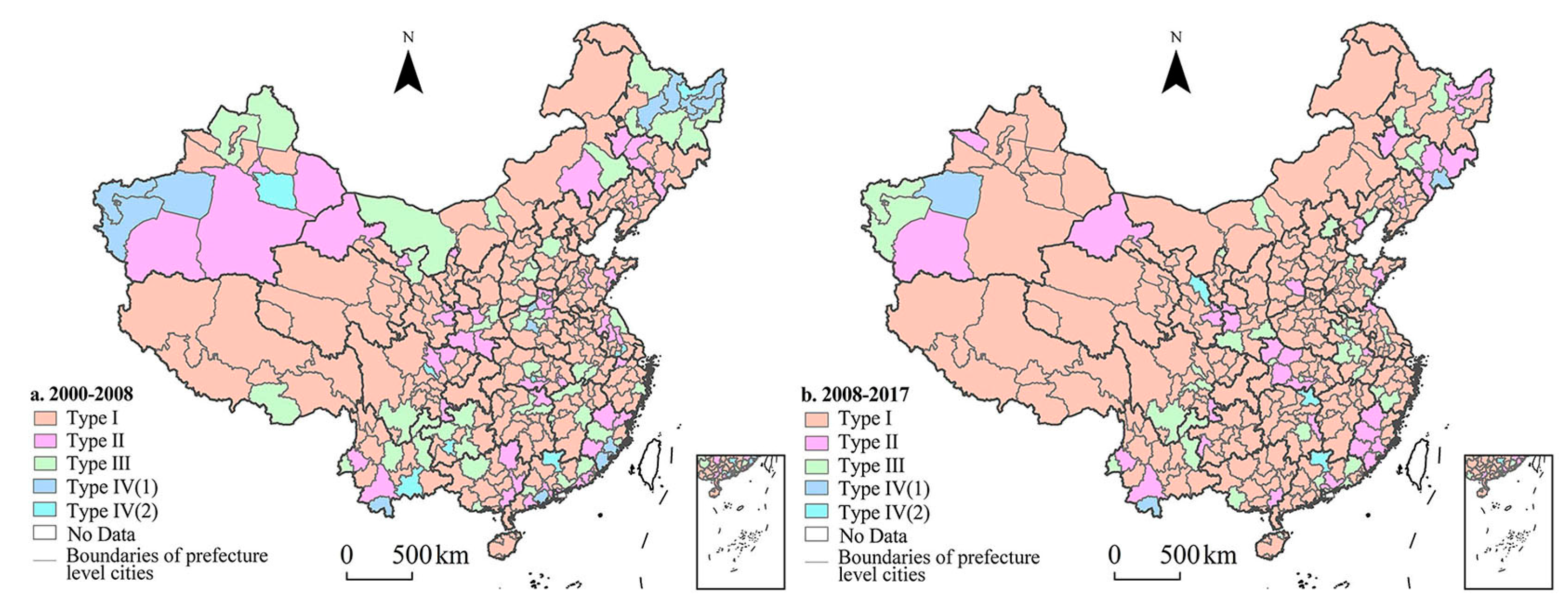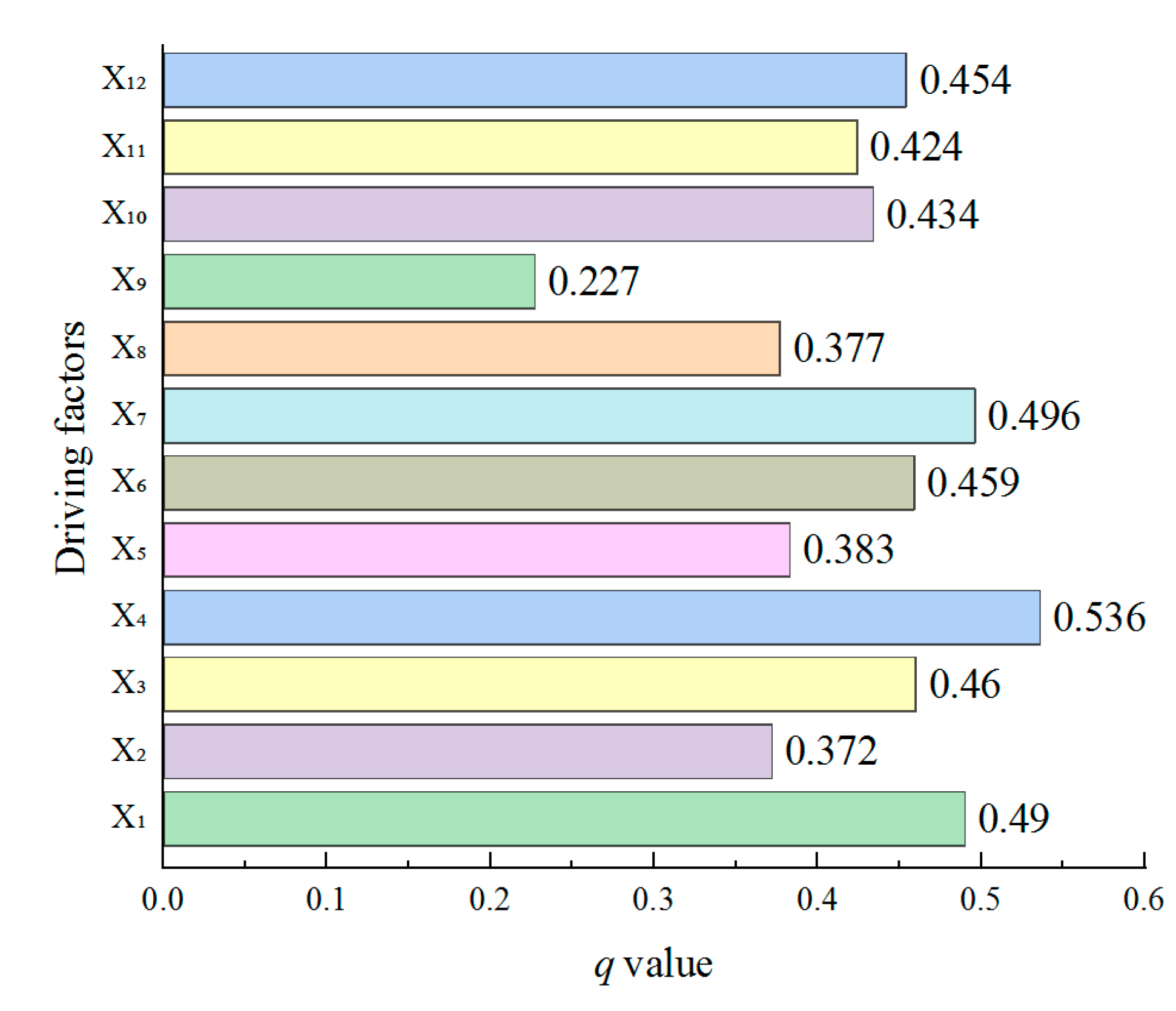Spatiotemporal Pattern and Driving Factors of Urban Sprawl in China
Abstract
:1. Introduction
2. Data Sources
2.1. Data
2.2. Data Processing
3. Methods
3.1. Urban Sprawl Index
3.2. Exploratory Spatiotemporal Data Analysis (ESTDA)
3.3. Indicator System of Driving Factors
3.4. Geodetector
4. Results
4.1. General Characteristics of Urban Sprawl
4.2. Spatial and Temporal Patterns of USI
4.3. Driving Factors of Urban Sprawl
4.3.1. Factor Detection Analysis
4.3.2. Interaction Detection Analysis
5. Discussion
5.1. Comparison with Other Studies
5.2. Policy Implications
5.3. Research Limitations and Prospects
6. Conclusions
- (1)
- China experienced moderate-to-high urban sprawl development from 2000 to 2017. In terms of spatial distribution, the USI was high in the northwest and low in the southeast. Changes in the USI increasingly appeared in prefecture-level cities located at boundaries between provinces.
- (2)
- The local spatial stability of the USI gradually decreased from southeast to northwest and northeast. There was no evident spatiotemporal transformation, strong spatial cohesion, relatively stable spatial pattern, or specific transfer inertia of the USI.
- (3)
- The gross regional product (GRP) of the tertiary industry, the general GRP, and investment in real estate development were the most important factors affecting the sprawl in cities at the prefecture level and above in China.
Author Contributions
Funding
Institutional Review Board Statement
Informed Consent Statement
Data Availability Statement
Conflicts of Interest
References
- Ewing, R. Is Los Angeles-style sprawl desirable? J. Am. Plan. Assoc. 1997, 63, 107–126. [Google Scholar] [CrossRef]
- Lityński, P. The Intensity of Urban Sprawl in Poland. ISPRS Int. J. Geo-Inf. 2021, 10, 95. [Google Scholar] [CrossRef]
- Feng, Y.; Wang, X.; Du, W.; Liu, J.; Li, Y. Spatiotemporal characteristics and driving forces of urban sprawl in China during 2003–2017. J. Clean. Prod. 2019, 241, 118061. [Google Scholar] [CrossRef]
- Chen, L.; Ren, C.Y.; Zhang, B.; Wang, Z.M. Quantifying urban land sprawl and its driving forces in Northeast China from 1990 to 2015. Sustainability 2018, 10, 188. [Google Scholar] [CrossRef] [Green Version]
- Lin, Y.C.; Li, Y.L.; Ma, Z.L. Exploring the interactive development between population urbanization and land urbanization: Evidence from Chongqing, China (1998–2016). Sustainability 2018, 10, 1741. [Google Scholar] [CrossRef] [Green Version]
- Chen, H.; Jia, B.; Lau, S.S.Y. Sustainable urban form for Chinese compact cities: Challenges of a rapid urbanized economy. Habitat Int. 2008, 32, 28–40. [Google Scholar] [CrossRef]
- Tan, M.; Li, X.; Xie, H. Urban land expansion and arable land loss in China—A case study of Beijing-Tianjin-Hebei region. Land Use Policy 2005, 22, 187–196. [Google Scholar] [CrossRef]
- Li, G.; Li, F. Urban sprawl in China: Differences and socioeconomic drivers. Sci. Total Environ. 2019, 673, 367–377. [Google Scholar] [CrossRef]
- Jin, X.; Long, Y.; Sun, W.; Lu, Y.; Yang, X.; Tang, J. Evaluating cities’ vitality and identifying ghost cities in china with emerging geographical data. Cities 2017, 63, 98–109. [Google Scholar] [CrossRef]
- Leichtle, T.; Lakes, T.; Zhu, X.X.; Taubenbck, H. Has dongying developed to a ghost city?—Evidence from multi-temporal population estimation based on vhr remote sensing and census counts. Comput. Environ. Urban Syst. 2019, 78, 101372. [Google Scholar] [CrossRef]
- Morano, P.; Guarini, M.R.; Sica, F.; Anelli, D. Ecosystem Services and Land Take. A Composite Indicator for the Assessment of Sustainable Urban Projects. In Proceedings of the International Conference on Computational Science and Its Applications, Cagliari, Italy, 13–16 September 2021; pp. 215–225. [Google Scholar] [CrossRef]
- Deal, B.; Schunk, D. Spatial dynamic modeling and urban land use transformation: A simulation approach to assessing the costs of urban sprawl. Ecol. Econ. 2004, 51, 79–95. [Google Scholar] [CrossRef]
- Zambon, I.; Benedetti, A.; Ferrara, C.; Salvati, L. Soil matters? A multivariate analysis of socioeconomic constraints to urban expansion in Mediterranean Europe. Ecol. Econ. 2018, 146, 173–183. [Google Scholar] [CrossRef]
- Shu, C.; Xie, H.L.; Jiang, J.F.; Chen, Q.R. Is urban land development driven by economic development or fiscal revenue stimuli in China? Land Use Policy 2018, 77, 107–115. [Google Scholar] [CrossRef]
- Galster, G.; Hanson, R.; Ratcliffe, M.R. Wrestling Sprawl to the Ground: Defining and Measuring an Elusive Concept. Hous. Policy Debate 2001, 12, 681–717. [Google Scholar] [CrossRef]
- Zhen, L.; Liu, S.; Wei, Q.; Jin, H. Urban sprawl among Chinese cities of different population sizes. Habitat Int. 2018, 79, 89–98. [Google Scholar] [CrossRef]
- Gottmann, J. Megalopolis: The Urbanized Northeastern Seaboard of the United States; Twentieth Century Fund: New York, NY, USA, 1961. [Google Scholar]
- Yue, W.; Liu, Y.; Fan, P. Measuring urban sprawl and its drivers in large Chinese cities: The case of Hangzhou. Land Use Policy 2013, 31, 358–370. [Google Scholar] [CrossRef]
- Lang, R.E.; Lefurgy, J. Edgeless cities: Examining the noncentered metropolis. Hous. Policy Debate 2003, 14, 427–460. [Google Scholar] [CrossRef]
- Taiwo, O.J. Modelling the spatiotemporal patterns of urban sprawl in Ibadan metropolis between 1984 and 2013 in Nigeria. Model. Earth Syst. Environ. 2021. [Google Scholar] [CrossRef]
- Lopez, R.; Hynes, H.P. Sprawl in the 1990s: Measurement, distribution, and trends. Urban Aff. Rev. 2003, 38, 325–355. [Google Scholar] [CrossRef]
- Fallah, B.N.; Partridge, M.D.; Olfert, M.R. Urban sprawl and productivity: Evidence from US metropolitan areas. Pap. Reg. Sci. 2011, 90, 451–472. [Google Scholar] [CrossRef]
- Qin, M.; Liu, X.Y.; Li, S.L. China’s “Mystery of Urban sprawl”—Spatial Panel Data Analysis from the Perspective of Government Behavior. Econ. Perspect. 2016, 7, 21–33. (In Chinese) [Google Scholar]
- Nazarnia, N.; Schwick, C.; Jaeger, J.A.G. Accelerated urban sprawl in Montreal, Quebec City, and Zurich: Investigating the differences using time series 1951–2011. Ecol. Indic. 2016, 60, 1229–1251. [Google Scholar] [CrossRef]
- Deng, Y.; Qi, W.; Fu, B.J.; Wang, K.V. Geographical transformations of urban sprawl: Exploring the spatial heterogeneity across cities in China 1992–2015. Cities 2020, 105, 102415. [Google Scholar] [CrossRef]
- Ewing, R.; Hamidi, S. Compactness versus Sprawl: A Review of Recent Evidence from the United States. J. Plan. Lit. 2015, 30, 413–432. [Google Scholar] [CrossRef]
- Burchfield, M.; Overman, H.; Puga, D.; Turner, M. Causes of Sprawl: A Portrait from Space. Q. J. Econ. 2006, 121, 587–633. [Google Scholar] [CrossRef]
- Pirotte, A.; Madre, J.L. Determinants of urban sprawl in france: An analysis using a hierarchical bayes approach on panel data. Urban Stud. 2010, 48, 2865–2886. [Google Scholar] [CrossRef]
- Zhang, X.; Lu, L.; Ren, Y.; Xu, Y.; Zhang, H. Spatiotemporal Evolution Pattern of Urban Sprawl in China and Its Influencing Factors. Econ. Geogr. 2021, 41, 77–85. (In Chinese) [Google Scholar] [CrossRef]
- Jiang, G.; Ma, W.; Qu, Y.; Zhang, R.J.; Zhou, D.Y. How does sprawl differ across urban built-up land types in China? A spatial-temporal analysis of the Beijing metropolitan area using granted land parcel data. Cities 2016, 58, 1–9. [Google Scholar] [CrossRef]
- Monkkonen, P.; Comandon, A.; Escamilla, J.A.M.; Guerrac, E. Urban sprawl and the growing geographic scale of segregation in Mexico, 1990–2010. Habitat Int. 2018, 73, 89–95. [Google Scholar] [CrossRef] [Green Version]
- Puertas, O.L.; Henríquez, C.; Meza, F.J. Assessing spatial dynamics of urban growth using an integrated land use model. Application in Santiago Metropolitan Area, 2010–2045. Land Use Policy 2014, 38, 415–425. [Google Scholar] [CrossRef]
- Elvidge, C.D.; Tuttle, B.T.; Sutton, P.S.; Baugh, K.E.; Howard, A.T.; Milesi, C.; Bhaduri, B.; Nemani, R. Global distribution and density of constructed impervious surfaces. Sensors 2007, 7, 1962–1979. [Google Scholar] [CrossRef]
- Liu, Z.; He, C.; Zhang, Q.; Huang, Q.X.; Yang, Y. Extracting the dynamics of urban expansion in China using DMSP-OLS nighttime light data from 1992 to 2008. Landsc. Urban Plan. 2012, 106, 62–72. [Google Scholar] [CrossRef]
- Zhao, M.; Zhou, Y.; Li, X.; Zhou, C.H.; Cheng, W.M.; Li, M.C.; Huang, K. Building a Series of Consistent Night-Time Light Data (1992–2018) in Southeast Asia by Integrating DMSP-OLS and NPP-VIIRS. IEEE Trans. Geosci. Remote Sens. 2020, 58, 1843–1856. [Google Scholar] [CrossRef]
- Li, X.; Li, D.; Xu, H.; Wu, C.Q. Intercalibration between DMSP/OLS and VIIRS night-time light images to evaluate city light dynamics of Syria’s major human settlement during Syrian Civil War. Int. J. Remote Sens. 2017, 38, 5934–5951. [Google Scholar] [CrossRef]
- Zheng, Q.; Weng, Q.; Wang, K. Developing a new cross-sensor calibration model for DMSP-OLS and Suomi- NPP VIIRS night-light imageries. ISPRS-J. Photogramm. Remote Sens. 2019, 153, 36–47. [Google Scholar] [CrossRef]
- Fan, J.; Zhou, L. Three-dimensional intergovernmental competition and urban sprawl: Evidence from Chinese prefectural-level cities. Land Use Policy 2019, 87, 104035. [Google Scholar] [CrossRef]
- Xu, P.; Jin, P.; Yang, Y.; Wang, Q. Evaluating Urbanization and Spatial-Temporal Pattern Using the DMSP/OLS Nighttime Light Data: A Case Study in Zhejiang Province. Math. Probl. Eng. 2016, 2016, 9850890. [Google Scholar] [CrossRef] [Green Version]
- Mao, Q.; Long, Y.; Wu, K. Spatio-temporal changes of population density and exploration on urbanization pattern in china: 2000–2010. City Plan. Rev. 2015, 39, 38–43. (In Chinese) [Google Scholar] [CrossRef]
- Rey, S.J.; Janikas, M.V. STARS: Space-time analysis of regional systems. Geogr. Anal. 2016, 38, 67–86. [Google Scholar] [CrossRef]
- Rey, S.J.; Murray, A.T.; Anselin, L. Visualizing regional income distribution dynamics. Lett. Spat. Resour. Sci. 2011, 4, 81–90. [Google Scholar] [CrossRef]
- Wang, J.F.; Xu, C.D. Geodetector: Principle and prospective. Acta Geogr. Sin. 2017, 72, 116–134. (In Chinese) [Google Scholar] [CrossRef]
- Liu, J.; Zhang, Z.; Xu, X. Spatial patterns and driving forces of land use change in China during the early 21st century. J. Geogr. Sci. 2010, 20, 483–494. [Google Scholar] [CrossRef]
- Vasenev, V.I.; Stoorvogel, J.J.; Leemans, R.; Valentini, R.; Hajiaghayeva, R.A. Projection of urban expansion and related changes in soil carbon stocks in the Moscow Region. J. Clean. Prod. 2018, 170, 902–914. [Google Scholar] [CrossRef]
- Yang, Y.C.; Liu, J.H.; Zhang, Y.T. An analysis of the implications of China’s urbanization policy for economic growth and energy consumption. J. Clean. Prod. 2017, 161, 1251–1262. [Google Scholar] [CrossRef]
- Tian, L.; Ge, B.Q.; Li, Y.F. Impacts of state-led and bottom-up urbanization on land use change in the peri-urban areas of Shanghai: Planned growth or uncontrolled sprawl? Cities 2017, 60, 476–486. [Google Scholar] [CrossRef]
- Hamidi, S.; Ewing, R. A longitudinal study of changes in urban sprawl between 2000 and 2010 in the United States. Landsc. Urban Plan 2014, 128, 72–82. [Google Scholar] [CrossRef]
- Weilenmann, B.; Seidl, I.; Schulz, T. The socio-economic determinants of urban sprawl between 1980 and 2010 in Switzerland. Landsc. Urban Plan 2017, 157, 468–482. [Google Scholar] [CrossRef]
- Ye, X.Y. A framework for exploratory spacetime analysis of economic data. Ann. Reg. Sci. 2013, 50, 315–339. [Google Scholar] [CrossRef]
- Zhong, Y.; Lin, A.; He, L.J.; Zhou, Z.G.; Yuan, M.X. Spatiotemporal dynamics and driving forces of urban land-use expansion: A case study of the Yangtze River Economic Belt. China Rem. Sens. 2020, 12, 287. [Google Scholar] [CrossRef] [Green Version]
- Liu, X.J.; Xia, S.Y.; Yang, Y.; Wu, J.F.; Zhou, Y.N.; Ren, Y.W. Spatiotemporal dynamics and impacts of socioeconomic and natural conditions on PM2.5 in the Yangtze River Economic Belt. Environ. Pollut. 2020, 263, 114569. [Google Scholar] [CrossRef]
- Shrestha, A.; Luo, W. Analysis of groundwater nitrate contamination in the central valley: Comparison of the geodetector method, principal component analysis and geographically weighted regression. ISPRS Int. J. Geo-Inf. 2017, 6, 297. [Google Scholar] [CrossRef]
- Zhu, L.J.; Meng, J.J.; Zhu, L.K. Applying Geodetector to disentangle the contributions of natural and anthropogenic factors to NDVI variations in the middle reaches of the Heihe River Basin. Ecol. Indic. 2020, 117, 106545. [Google Scholar] [CrossRef]
- Shi, T.Z.; Hu, Z.W.; Shi, Z.; Guo, L.; Chen, Y.Y.; Li, Q.Q.; Wu, G.F. Geo-detection of factors controlling spatial patterns of heavy metals in urban topsoil using multi-source data. Sci. Total Environ. 2018, 643, 451–459. [Google Scholar] [CrossRef] [PubMed]
- Polykretis, C.; Alexakis, D.D. Spatial stratified heterogeneity of fertility and its association with socio-economic determinants using Geographical Detector: The case study of Crete Island, Greece. Appl. Geogr. 2021, 127, 102384. [Google Scholar] [CrossRef]
- Wang, L.G.; Han, H.Y.; Lai, S.K. Do plans contain urban sprawl? A comparison of Beijing and Taipei. Habitat Int. 2014, 42, 121–130. [Google Scholar] [CrossRef]






| Target Layer | Indicator Layer | Unit |
|---|---|---|
| Economic factors | Gross Regional Product (GRP) X1 | CNY 10,000 |
| Per capita GRP X2 | yuan | |
| The total value in secondary industry X3 | CNY 10,000 | |
| The total value in tertiary industry X4 | CNY 10,000 | |
| Employees in the secondary industries X5 | person | |
| Employees in the tertiary industries X6 | person | |
| Investment in real estate development X7 | CNY 10,000 | |
| Amount of foreign capital actually utilized X8 | USD million | |
| Social factors | Total population at year-end X9 | 10,000 persons |
| Total retail sales of consumer goods X10 | CNY 10,000 | |
| Government regulation factors | Public finance expenditure X11 | CNY 10,000 |
| Area of city paved roads X12 | hm2 |
| Time Interval | 1/t2 | HH | LH | LL | HL | Transition Type | n | Proportion | SF | SC |
|---|---|---|---|---|---|---|---|---|---|---|
| 2000–2008 | HH | 0.730 | 0.085 | 0.053 | 0.132 | Type I | 221 | 0.644 | 0.289 | 0.190 |
| LH | 0.243 | 0.615 | 0.071 | 0.071 | Type II | 50 | 0.146 | |||
| LL | 0.137 | 0.118 | 0.510 | 0.235 | Type III | 49 | 0.143 | t = 0.390 | ||
| HL | 0.257 | 0.043 | 0.114 | 0.586 | Type IV | 23 | 0.067 | |||
| 2008–2017 | HH | 0.850 | 0.059 | 0.006 | 0.085 | Type I | 256 | 0.746 | 0.233 | 0.125 |
| LH | 0.2 | 0.646 | 0.108 | 0.046 | Type II | 39 | 0.114 | |||
| LL | 0.064 | 0.128 | 0.595 | 0.216 | Type III | 41 | 0.120 | t = 0.298 | ||
| HL | 0.192 | 0 | 0.090 | 0.718 | Type IV | 7 | 0.020 | |||
| X1 | X2 | X3 | X4 | X5 | X6 | X7 | X8 | X9 | X10 | X11 | X12 | |
|---|---|---|---|---|---|---|---|---|---|---|---|---|
| X1 | 0.490 | |||||||||||
| X2 | 0.958 | 0.372 | ||||||||||
| X3 | 0.791 | 0.961 | 0.460 | |||||||||
| X4 | 0.829 | 0.957 | 0.886 | 0.536 | ||||||||
| X5 | 0.826 | 0.934 | 0.854 | 0.874 | 0.383 | |||||||
| X6 | 0.926 | 0.983 | 0.968 | 0.942 | 0.925 | 0.459 | ||||||
| X7 | 0.902 | 0.872 | 0.883 | 0.883 | 0.879 | 0.932 | 0.476 | |||||
| X8 | 0.918 | 0.903 | 0.923 | 0.946 | 0.898 | 0.966 | 0.885 | 0.377 | ||||
| X9 | 0.961 | 0.976 | 0.964 | 0.964 | 0.952 | 0.938 | 0.974 | 0.965 | 0.227 | |||
| X10 | 0.875 | 0.936 | 0.883 | 0.901 | 0.910 | 0.875 | 0.878 | 0.911 | 0.913 | 0.434 | ||
| X11 | 0.918 | 0.903 | 0.938 | 0.937 | 0.858 | 0.900 | 0.906 | 0.903 | 0.936 | 0.855 | 0.424 | |
| X12 | 0.857 | 0.964 | 0.824 | 0.866 | 0.930 | 0.933 | 0.852 | 0.940 | 0.932 | 0.899 | 0.885 | 0.454 |
Publisher’s Note: MDPI stays neutral with regard to jurisdictional claims in published maps and institutional affiliations. |
© 2021 by the authors. Licensee MDPI, Basel, Switzerland. This article is an open access article distributed under the terms and conditions of the Creative Commons Attribution (CC BY) license (https://creativecommons.org/licenses/by/4.0/).
Share and Cite
Zhang, X.; Pan, J. Spatiotemporal Pattern and Driving Factors of Urban Sprawl in China. Land 2021, 10, 1275. https://doi.org/10.3390/land10111275
Zhang X, Pan J. Spatiotemporal Pattern and Driving Factors of Urban Sprawl in China. Land. 2021; 10(11):1275. https://doi.org/10.3390/land10111275
Chicago/Turabian StyleZhang, Xin, and Jinghu Pan. 2021. "Spatiotemporal Pattern and Driving Factors of Urban Sprawl in China" Land 10, no. 11: 1275. https://doi.org/10.3390/land10111275
APA StyleZhang, X., & Pan, J. (2021). Spatiotemporal Pattern and Driving Factors of Urban Sprawl in China. Land, 10(11), 1275. https://doi.org/10.3390/land10111275






